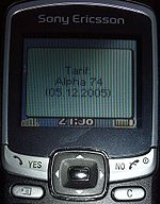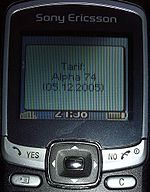
Unstructured Supplementary Service Data
Encyclopedia

Wireless Application Protocol
Wireless Application Protocol is a technical standard for accessing information over a mobile wireless network.A WAP browser is a web browser for mobile devices such as mobile phones that uses the protocol.Before the introduction of WAP, mobile service providers had limited opportunities to offer...
browsing, prepaid callback service, mobile-money services, location-based content services, menu-based information services, and as part of configuring the phone on the network.
USSD messages are up to 182 alphanumeric characters in length. Unlike Short Message Service (SMS)
SMS
SMS is a form of text messaging communication on phones and mobile phones. The terms SMS or sms may also refer to:- Computer hardware :...
messages, USSD messages create a real-time connection during a USSD session. The connection remains open, allowing a two-way exchange of a sequence of data. This makes USSD more responsive than services that use SMS.
Uses
The user composes a message—usually rather cryptic—on the phone keyboard. The phone sends it to the phone company network, where it is received by a computer dedicated to USSD. The answer from this computer is sent back to the phone. The answer could be seen on the phone screen, but it is usually with a very basic presentation. The messages sent over USSD are not defined by any standardization body, so each network operator can implement whatever it finds suitable for its customers.USSD can be used to provide independent calling services such as a callback
Callback (telecommunications)
In telecommunications, a callback occurs when the originator of a call is immediately called back in a second call as a response.- International calling :...
service (e.g. cheaper phone charges while roaming) or interactive data service (e.g. stock quotes, sports results).
USSD is commonly used by pre-paid GSM cellular phones to query the available balance. The vendor's "check balance" application hides the details of the USSD protocol from the user.
USSD can also be used to refill user's money balance on phone (SIM card to be exact).
Some payment methods, such as SharEpay, WING in Cambodia, SWAP Mobile in South Africa
South Africa
The Republic of South Africa is a country in southern Africa. Located at the southern tip of Africa, it is divided into nine provinces, with of coastline on the Atlantic and Indian oceans...
, Mobipay in Spain
Spain
Spain , officially the Kingdom of Spain languages]] under the European Charter for Regional or Minority Languages. In each of these, Spain's official name is as follows:;;;;;;), is a country and member state of the European Union located in southwestern Europe on the Iberian Peninsula...
, M-Pesa
M-Pesa
M-PESA is the product name of a mobile-phone based money transfer service for Safaricom, which is a Vodafone affiliate. It was initially developed by Sagentia before transitioning to IBM...
in Tanzania
Tanzania
The United Republic of Tanzania is a country in East Africa bordered by Kenya and Uganda to the north, Rwanda, Burundi, and the Democratic Republic of the Congo to the west, and Zambia, Malawi, and Mozambique to the south. The country's eastern borders lie on the Indian Ocean.Tanzania is a state...
(but not in Kenya
Kenya
Kenya , officially known as the Republic of Kenya, is a country in East Africa that lies on the equator, with the Indian Ocean to its south-east...
, where M-Pesa menus are provided by STK
SIM Application Toolkit
SIM Application Toolkit is a standard of the GSM system which enables the Subscriber Identity Module to initiate actions which can be used for various value-added services....
rather than USSD), and mPay in Poland
Poland
Poland , officially the Republic of Poland , is a country in Central Europe bordered by Germany to the west; the Czech Republic and Slovakia to the south; Ukraine, Belarus and Lithuania to the east; and the Baltic Sea and Kaliningrad Oblast, a Russian exclave, to the north...
use USSD.
Some operators use USSD to provide access to real-time updates from social-networking websites like Facebook
Facebook
Facebook is a social networking service and website launched in February 2004, operated and privately owned by Facebook, Inc. , Facebook has more than 800 million active users. Users must register before using the site, after which they may create a personal profile, add other users as...
and Twitter
Twitter
Twitter is an online social networking and microblogging service that enables its users to send and read text-based posts of up to 140 characters, informally known as "tweets".Twitter was created in March 2006 by Jack Dorsey and launched that July...
.
Technical details
All GSM phones have USSD capability. It is generally associated with real-time or instant messaging services. There is no store-and-forward capability, as is typical of other short-message protocols like SMS—in other words, an SMSCShort message service center
A short message service center is a network element in the mobile telephone network which delivers SMS messages.-Operation:When a user sends a text message to another user, the message gets stored in the SMSC which delivers it to the destination user when they are available...
is not present in the processing path.
USSD Phase 1, specified in GSM 02.90, only supports mobile-initiated ("pull") operation. In the core network
Network Switching Subsystem
Network switching subsystem is the component of a GSM system that carries out call switching and mobility management functions for mobile phones roaming on the network of base stations...
, the message is delivered over MAP
Mobile Application Part
The Mobile Application Part is an SS7 protocol which provides an application layer for the various nodes in GSM and UMTS mobile core networks and GPRS core networks to communicate with each other in order to provide services to mobile phone users...
. USSD Phase 2, specified in GSM 03.90, supports network-initiated ("push") operation as well.
Format
A typical USSD message starts with an asterisk (*) followed by digits that comprise commands or data. Groups of digits may be separated by additional asterisks. The message is terminated with a number sign (#).Example USSD codes:
After entering a USSD code on a GSM handset, the reply from the GSM operator is displayed within a few seconds.

